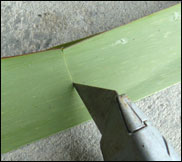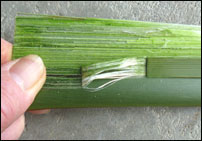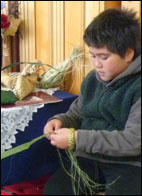Flax weaving on a marae
5 November 2012Click here to visit an upgraded version of this blog post on my new website at alibrown.nz.
 This eye-catching pattern belongs to a well-worn basket (kete whakairo) that a participant brought to a two-day weaving workshop at Waikawa marae (raranga wananga noho marae), which I was invited to tutor at recently. What particularly struck me is its vivid three-dimensional effect, which is hard to fully appreciate unless the kete is seen in the flesh, so to speak. I also like the way the pattern can be seen as either a checkerboard of vertical squares or as a checkerboard of diagonal squares. It’s woven in blocks of one-under, one-over (takitahi), interspersed with blocks of strips woven in longer weaves. The tightly woven blocks keep the weaving very even and the old kete still has a good shape. If you’d like to try it out, it’s pattern #76 in Mick Pendergrast’s book, Raranga Whaikaro.
This eye-catching pattern belongs to a well-worn basket (kete whakairo) that a participant brought to a two-day weaving workshop at Waikawa marae (raranga wananga noho marae), which I was invited to tutor at recently. What particularly struck me is its vivid three-dimensional effect, which is hard to fully appreciate unless the kete is seen in the flesh, so to speak. I also like the way the pattern can be seen as either a checkerboard of vertical squares or as a checkerboard of diagonal squares. It’s woven in blocks of one-under, one-over (takitahi), interspersed with blocks of strips woven in longer weaves. The tightly woven blocks keep the weaving very even and the old kete still has a good shape. If you’d like to try it out, it’s pattern #76 in Mick Pendergrast’s book, Raranga Whaikaro.
Weaving workshops can be learning experiences for everyone involved, including the tutor and it’s always good to pick up new weaving tips and see what people have made. This workshop included Māori language (te reo) and songs (waiata) as well as weaving, which is why I’ve included some Māori words in this blog post.
Marama, an experienced weaver, brought along some of the kete whakairo she has woven recently, as well as a baby pod (not for carrying) (wahakura).  She mentioned that there were a couple of things she would do differently next time she wove a wahakura. Firstly, this carrier wasn’t quite wide enough for a baby, so to make it wider she would add more strips into each starting plait. The other tip she gave is to use a really strong flax for the wahakura as ordinary flax isn’t strong enough to give structure to the sides and hold them upright. For more weaving tips check out Rita Baker’s YouTube videos tutorial 1 and tutorial 2.
She mentioned that there were a couple of things she would do differently next time she wove a wahakura. Firstly, this carrier wasn’t quite wide enough for a baby, so to make it wider she would add more strips into each starting plait. The other tip she gave is to use a really strong flax for the wahakura as ordinary flax isn’t strong enough to give structure to the sides and hold them upright. For more weaving tips check out Rita Baker’s YouTube videos tutorial 1 and tutorial 2.
 A striking and well-made sculptural piece brought along by Helen was the result of weaving a corner in a different way. Helen had started to weave a kete but instead of crossing two strips to start the corner, she took them out to each side. This inspired her to weave the bird instead and the outwards turn became the start of wings. Using a combination of her sculptural and weaving skills, Helen ended up with this magnificent bird (kāhu). It wasn’t what she started out to weave but it turned out to be a unique piece of weaving.
A striking and well-made sculptural piece brought along by Helen was the result of weaving a corner in a different way. Helen had started to weave a kete but instead of crossing two strips to start the corner, she took them out to each side. This inspired her to weave the bird instead and the outwards turn became the start of wings. Using a combination of her sculptural and weaving skills, Helen ended up with this magnificent bird (kāhu). It wasn’t what she started out to weave but it turned out to be a unique piece of weaving.
One of the projects that the weavers are working on for the marae is a mat (whāriki) with flat joins. The flat joins are important as the mat will form the ceremonial base on which to rest a coffin at a tangi. The usual method of joining weaving using a plait wasn’t suitable as it is too bulky. The method they were using to make the flat join is the one shown on page 151 in Peter Buck’s book The coming of the Māori, where the new and old strips are worked together as one and then the old strips are turned back and woven back down to lock them into place.
 Several weavers decided to make ketes using the whitebait (Koeaea) pattern which requires a plaited base to set the pattern (whakapapa). As I watched one of the weavers, Helen, preparing her strips, I noticed she used an extra step to prepare the fibre (muka) ends that I hadn’t encountered before. She made a cut half way through the thickness of the leaf where the fibre end would usually start in the traditional method of preparing fibre ends. She then folded the shiny side of the strip down,
Several weavers decided to make ketes using the whitebait (Koeaea) pattern which requires a plaited base to set the pattern (whakapapa). As I watched one of the weavers, Helen, preparing her strips, I noticed she used an extra step to prepare the fibre (muka) ends that I hadn’t encountered before. She made a cut half way through the thickness of the leaf where the fibre end would usually start in the traditional method of preparing fibre ends. She then folded the shiny side of the strip down,  at the cut, onto the shiny side of the leaf, held the strip very tightly at this point and pulled the strip down sharply as usual. The cut helped to release the muka from the outer green of the leaf although some fibre ends may still need some scraping to remove any excess green outer leaf that remains.
at the cut, onto the shiny side of the leaf, held the strip very tightly at this point and pulled the strip down sharply as usual. The cut helped to release the muka from the outer green of the leaf although some fibre ends may still need some scraping to remove any excess green outer leaf that remains.
 During the weekend, people wove flowers (putiputi) using my book as a guide, large containers (waikawa), small baskets (kono), including those with flaps, baskets with plaited tops, a three-cornered basket, wristbands, balls and rope. The young boys (tamariki tāne) learned to plait for the first time and made a plaited rope (whiri kawe) with shredded flax. At the other end of the scale, Peter, an experienced stone carver, was making a fine rounded four plait rope (tōpuku) to use for carrying fine stone vessels.
During the weekend, people wove flowers (putiputi) using my book as a guide, large containers (waikawa), small baskets (kono), including those with flaps, baskets with plaited tops, a three-cornered basket, wristbands, balls and rope. The young boys (tamariki tāne) learned to plait for the first time and made a plaited rope (whiri kawe) with shredded flax. At the other end of the scale, Peter, an experienced stone carver, was making a fine rounded four plait rope (tōpuku) to use for carrying fine stone vessels.
 I thoroughly enjoyed my weekend with the people of Waikawa marae. Their hospitality was welcoming and their enthusiasm for weaving was exciting. It was a large group with weavers of varying abilities which brought a vitality to the group and a buzz of conversation as people helped each other. Waikawa marae plans to have another raranga wananga in 2013 and to continue with regular weaving sessions.
I thoroughly enjoyed my weekend with the people of Waikawa marae. Their hospitality was welcoming and their enthusiasm for weaving was exciting. It was a large group with weavers of varying abilities which brought a vitality to the group and a buzz of conversation as people helped each other. Waikawa marae plans to have another raranga wananga in 2013 and to continue with regular weaving sessions.
© Alison Marion Brown 2012.


November 7th, 2012 at 8:01 pm
I went to the weaving hui to make and weave putiputi “lily and lotus flowers” and came away from hui having made and able to remember how to make those two articles.
What was also important was the whakawhanungatanga from participants to each other with a common interest. To see everyone working away was great.
Thank you again to you Ali we would like you to visit us here as well.
na Karen
November 10th, 2012 at 9:35 am
Hi Karen
I’m glad you enjoyed the raranga wananga at Waikawa marae. I’d welcome the chance to tutor in Maungamanu. If you can get a group together, let me know. This year’s out for me but next year would be fine.
November 11th, 2012 at 2:56 pm
Hi Ali
The weekend sounds great. Just pointing out that wahakura are designed as a safe sleeping environment for babies (usually in mum and dads bed) not a carrying basket (hence the lack of handles) Lots of info out there on them.
Cheers, Wendy
November 12th, 2012 at 6:54 pm
Hi Wendy
Thanks for pointing this detail out. Yes the wahakura is a bassinet, not a carrier. Dr David Tipene-Leach has a good description of the wahakura project in the PDF file I linked to.
November 17th, 2012 at 1:47 pm
Hi Ali,
thanks for including the link to the Wahakura tutorial!
Also - the way Helen got her muka ends for her whiri Kete is the way I learnt to do it as well - it works particularly well if the Harakeke has not much muka for “ripping” - either or works for me.
Lastly - for anyone in the upper North Island - there is a big weaving wananga coming up in January in Raglan - that is organised by Nga Hua O Te Rito - normally this “big one” would be in Kawhia but they are renovating the Wharenui there. Details to follow soon or through me.
January 3rd, 2013 at 12:30 pm
A wahine roopu has been establish on our Marae to overseer and make Tuku panels and Whariki for our Wharenui
We have no idea where to begin or direction as to where we seek funding. I hope that contact with your foundation will be able to help us. We are a Kingitanga Marae in Waikato.
Teena kOe
Bunna Rakete
Kaiwhakahaere
September 6th, 2013 at 9:45 am
Tena koe Bunna
Would love to be involved in your raranga roopu.Can you email me details or requirements to participate
Na
Judy
September 7th, 2013 at 12:39 pm
Tena koe Bunna
Have you tried CreativeNZ for funding?
June 8th, 2017 at 5:29 pm
Hi Ali, I would like to learn how to weave a Wahakura. Do you know of any place who teaches weaving in Porirua area.
Thanks Bernie
June 9th, 2017 at 12:54 pm
Hi Bernice, Check out the links on this page for instructions on weaving a wahakura. Sorry I don’t know of anyone in Porirua who teaches this.
June 20th, 2018 at 10:57 am
WE NEED TO KNOW HOW TO MAKE A WAHAKURA and this is it .
Thank You C;